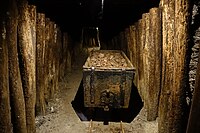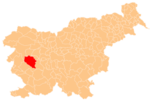| Idrija | |
|---|---|
| Town | |
      From top, left to right: Overview of Idrija, Gewerkenegg Castle, Miners' Theatre, Vega Gymnasium, Town Park, Town Center From top, left to right: Overview of Idrija, Gewerkenegg Castle, Miners' Theatre, Vega Gymnasium, Town Park, Town Center | |
 Coat of arms Coat of arms | |
 | |
| Coordinates: 46°00′09″N 14°01′39″E / 46.00250°N 14.02750°E / 46.00250; 14.02750 | |
| Country | |
| Traditional region | Slovene Littoral |
| Statistical region | Gorizia |
| Municipality | Idrija |
| Area | |
| • Total | 13.1 km (5.1 sq mi) |
| Elevation | 334.5 m (1,097.4 ft) |
| Population | |
| • Total | 5,878 |
| Vehicle registration | GO |
| Climate | Cfb |
| UNESCO World Heritage Site | |
| Official name | Heritage of Mercury. Almadén and Idrija |
| Type | Cultural |
| Criteria | ii, iv |
| Designated | 2012 (36th session) |
| Reference no. | 1313 |
| Region | Europe and North America |
Idrija (pronounced [ˈiːdɾija] , in older sources Zgornja Idrija; German: (Ober)idria, Italian: Idria) is a town in western Slovenia. It is the seat of the Municipality of Idrija. Located in the traditional region of the Slovene Littoral and in the Gorizia Statistical Region, it is notable for its mercury mine with stores and infrastructure, as well as miners' living quarters, and a miners' theatre. Together with the Spanish mine at Almadén, it has been a UNESCO World Heritage Site since 2012. In 2011, Idrija was given the Alpine Town of the Year award.
Geography

The town of Idrija lies in the Idrija Basin, surrounded by the Idrija Hills. It is traversed by the Idrijca River, which is joined there by Nikova Creek. It includes the neighborhoods of Brusovše, Cegovnica, Prenjuta, and Žabja Vas close to the town center, as well as the more outlying hamlets of Češnjice, Ljubevč, Marof, Mokraška Vas, Podroteja, Staje, and Zahoda. The Marof hydroelectric plant is located on the Idrijca River on the northern outskirts of Idrija, between Marof and Mokraška Vas. Springs in the area include Podroteja Spring and Wild Lake on the Idrijca River south of the town.
History
| This section needs expansion. You can help by adding to it. (October 2012) |
Mercury was discovered in Idrija (known as Idria under Austrian rule) in the late 15th century (various sources cite 1490, 1492, and 1497). To support the mining activities, Gewerkenegg Castle was constructed between 1522 and 1533 by the mine owners. Mining operations were taken over by the government in 1580. The mineral idrialite, discovered here in 1832, is named after the town.
 1679 engraving by Johann Weikhard von Valvasor
1679 engraving by Johann Weikhard von Valvasor Anthony's Shaft, mine entrance
Anthony's Shaft, mine entrance Inside the mineIdrija mercury mine
Inside the mineIdrija mercury mine
In the Middle Ages, Idrija was managed by the Patriarchate of Aquileia and the Counts of Gorizia as part of the Governorate of Tolmin, which became independent in the 15th century. After 1500, Idrija was occupied for one year by the Republic of Venice (in 1508), but it was otherwise governed by the House of Habsburg. In March 1511, it was affected by the forceful 1511 Idrija earthquake. In the 18th century, Idrija gained the rights of a market town. From 1783 until the 1910s, it was part of the Inner Carniola Kreis. In 1920, it came under Italy with the Treaty of Rapallo. In September 1943, it became part of the Nazi Germany and was then heavily rocketed by the SAAF in 1945. After the war, it formed part of the Socialist Republic of Slovenia within Yugoslavia and became a town in independent Slovenia in June 1991.
Today, its inhabitants mostly consider it part of the Slovene Littoral.
| Year | Pop. | ±% |
|---|---|---|
| 1948 | 4,735 | — |
| 1953 | 5,013 | +5.9% |
| 1961 | 6,030 | +20.3% |
| 1971 | 6,933 | +15.0% |
| 1981 | 7,229 | +4.3% |
| 1991 | 6,195 | −14.3% |
| 2002 | 5,878 | −5.1% |
| 2011 | 5,955 | +1.3% |
| 2021 | 5,831 | −2.1% |
| Population size may be affected by changes in administrative divisions. | ||
Legend
According to legend, a bucket maker working in a local spring spotted a small amount of liquid mercury over 500 years ago. Idrija is one of the few places in the world where mercury occurs in both its elemental liquid state and as cinnabar (mercury sulfide) ore. The subterranean shaft mine entrance known as Anthony's Shaft (Antonijev rov) is used today for tours of the upper levels, complete with life-sized depictions of workers over the ages. The lower levels, which extend to almost 400 meters below the surface and are no longer being actively mined, are currently being cleaned up.
Church
The parish church in the town is dedicated to Saint Joseph the Worker and belongs to the Diocese of Koper. There are three other churches in Idrija, dedicated to the Holy Trinity, Saint Anthony of Padua, and Our Lady of Sorrows.
Notable people
Notable people who were born or lived in Idrija include:
- Aleš Bebler (1907–1981), Slovene Communist leader, resistance fighter, and diplomat
- Jožef Blasnik (1800–1872), printer, publisher
- Stanko Bloudek (1890–1959), designer
- Borut Božič (born 1980), professional road cyclist
- Aleš Čar (born 1971), writer
- Karel Dežman (1821–1889), Carniolan politician and scholar
- Damir Feigel (1879–1959), writer, journalist, cultural worker, satirist, humorist, father of Slovenian science fiction, national awakener and anti-fascism fighter
- Heinrich Freyer (1802–1866), Slovenian botanist, cartographer, pharmacist and natural scientist
- Ludvik Grilc (1851–1910), painter/portrait painter
- Belsazar Hacquet (1739/40–1815), French natural scientist
- Marko Hatlak (born 1980), accordionist
- Vladimír Karfík (1901–1996), Czechoslovak architect
- Eva Lucija Cecilija Viktorija Emilija Kraus, (1785–1845), Baroness of Wolsberg, lover of French Emperor Napoleon
- Marko V. Lipold (1816–1883), Miner, geologist and lawyer, known as the father of Slovenian geology
- Jožef Mrak (1709–1786), one of the most notable Slovenian polytechnicians
- Pier Paolo Pasolini (1922–1975), Italian film director and poet
- Vasja Pirc (1907–1980), chess grandmaster
- Nikolaj Pirnat (1903–1948), sculptor, painter, illustrator and author
- Zorko Prelovec (1887–1939), musician, composer, choir composition author
- Luka Rupnik (born 1993), Slovenian basketball player
- Marko Ivan Rupnik (born 1954), artist, philosopher and theologian
- Giovanni Antonio Scopoli (1723–1788), Italian natural scientist
- Jan Tratnik (born 1990), professional road cyclist
- Anton Aloys Wolf (1782–1859), Roman Catholic bishop, philanthropist, patron of literature
See also
- The ghost town of New Idria, California, a site of mercury mining during the 19th-century California Gold Rush, was named after Idrija.
References
- "Statistical Office of the Republic of Slovenia". Archived from the original on 2008-11-18. Retrieved 2013-01-26.
- ^ Leksikon občin kraljestev in dežel zastopanih v državnem zboru, vol. 6: Kranjsko. Vienna: C. Kr. Dvorna in Državna Tiskarna. 1906. pp. 124–125.
- Spezialkarte der Österreichisch-ungarischen Monarchie 1:75.000 Bischoflack und Oberidria (Map). Vienna: Militärgeographisches Institut. 1880. Retrieved January 7, 2019.
- Heritage of Mercury. Almadén and Idrija - UNESCO World Heritage Centre
- "Podroteja I – Idrijca". Hidrološki podatki. Agencija Republike Slovenije za okolje. Retrieved June 12, 2019.
- ^ Arko, Mihael. 1931. Zgodovina Idrije: po raznih arhivalnih in drugih virih. Ljubljana: Katoliška knjigarna, p. 1.
- Savnik, Roman, ed. 1968. Krajevni leksikon Slovenije, vol. 1. Ljubljana: Državna založba Slovenije, p. 70.
- ^ Kmecl, Matjaž. 1981. Treasures of Slovenia. Ljubljana: Cankarjeva založba, p. 262.
- Budkovič, Tomaž, Robert Šajn, & Mateja Gosar. 2003. "Vpliv delujočih in opuščenih rudnikov kovin in topilniških obratov na okolje v Sloveniji ." Geologija 46(1): 135–140, p. 136.
- Svetličič, Marjan, & Matija Rojec. 2000. "Kolektor." In Saul Estrin et al. (eds.), Foreign Direct Investment in Central Eastern Europe, pp. 3–28. New York: M. E. Sharpe, p. 3.
- "Top 10 attractions".
- Chisholm, Hugh, ed. (1911). "Idria" . Encyclopædia Britannica. Vol. 14 (11th ed.). Cambridge University Press. p. 289.
- Lampe, Katarinca (2007). Zgodovinski mejniki pri gospodarjenju z idrijskimi gozdovi (PDF).
- Golec, Boris (November 2015). "Kako so natali GORENJCI, DOLENJCI in NOTRANJCI ter kam so izginili KRANJCI" (PDF). SLO časi, kraji, ljudje. Slovenski zgodovinski magazin: 34.
- Grom, Janez Peter; Mikša, Peter; Fikfak, Alenka. "Pomen rapalske meje in vpliv na morfološki razvoj Idrije ter Žirov" [The Significance of the Rapallo Border and its Influence on the Morphological Development of Idrija and Žiri]. Annales. Series historia et sociologia (in Slovenian). 31 (1).
- Rijavec, Monika (2018). Jeklene ptice nad Idrijo (Motion picture) (in Slovenian). Directed by Dušan Moravec, Director of Picture Jurij Nemec.
- Geršič, Matjaž; Perko, Drago (2020). "Pokrajinska identiteta v Sloveniji" [Regional identity in Slovenia.]. In Brezovnik, Boštjan; Holcman, Borut; Trpin, Gorazd (eds.). Pokrajine v Sloveniji [Regions in Slovenia] (PDF) (in Slovenian). Inštitut za lokalno samoupravo. pp. 41–60. COBISS 21117187.
- Koper Diocese list of churches Archived 2009-03-06 at the Wayback Machine
External links
 Media related to Idrija at Wikimedia Commons
Media related to Idrija at Wikimedia Commons- Idrija on Geopedia
- Idrija municipal museum
- Local newspaper
- Tourist info
- Tourist information, a page in English about the town and its history
- Town portal
| Municipality of Idrija | ||
|---|---|---|
| Settlements | Administrative seat: Idrija |  |
| Landmarks | ||
| Notable people | ||
| World Heritage Sites in Slovenia | ||
|---|---|---|
| Cultural | ||
| Natural | ||